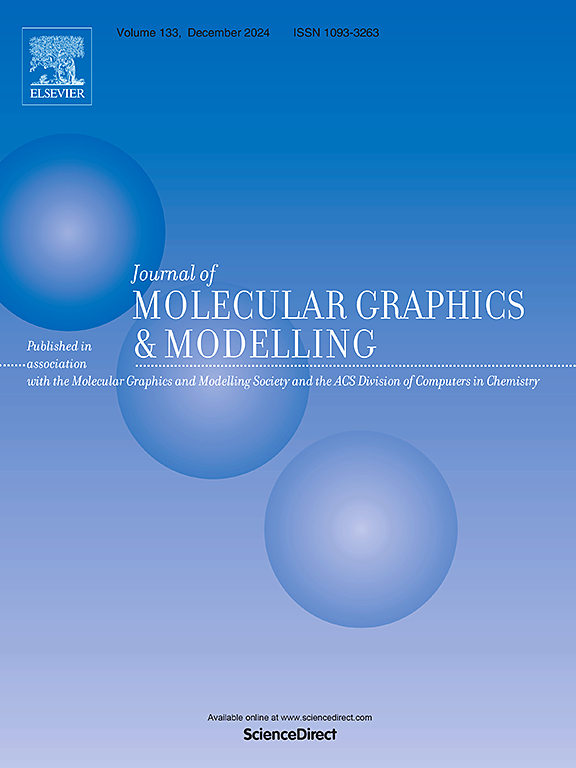通过过渡金属掺杂调整RRAM应用中ti3c2mxenes的性能:使用ab-initio计算
IF 3
4区 生物学
Q2 BIOCHEMICAL RESEARCH METHODS
引用次数: 0
摘要
专家们认为,由于MXene具有特殊的物理特性,因此可以用于制造有效的光电器件,是一种高度复杂的材料。在这里,计算了MXene的结构、声子、热力学稳定性、机械、电子和光学性质的理论方面,为科学家开发高性能MXene设备提供了路线图。在VASP代码框架内,采用平方波增强(PAW)方法研究了纯MXene Ti3C2和掺杂MXene Ti2XC2, (X = Ni, Fe, Mn和Co)的物理性质,得到Ti2NiC2, Ti2FeC2, Ti2MnC2和Ti2CoC2。结构性质分析结果表明,Ti3C2中掺杂原子的尺寸大于Ti原子的尺寸,则Ti3C2样品的晶格常数增大。计算了自旋极化和非自旋极化构型的能差、结合能和声子性质。电子性能分析结果表明,Ti3C2和Ti2NiC2表现为金属性质,其余样品表现为半导体性质:Ti2FeC2的带隙为0.21 eV, Ti2MnC2的带隙为0.1eV, Ti2CoC2的带隙为0.23eV。原始和掺杂的MXenes的机械稳定性也使用玻恩稳定性标准进行了测试。从声子对称点和玻恩稳定性判据证明,所有考虑的MXenes都是机械稳定的。根据光学性质的结果,所有MXene样品,特别是Ti2NiC2在红外区域具有高吸收率和低损失函数值,因此对光电应用,特别是RRAM器件特别有吸引力。本文章由计算机程序翻译,如有差异,请以英文原文为准。

Tailoring the properties of Ti3C2 MXenes via transition metal doping for RRAM applications: Using ab-initio calculation
Experts consider MXene as a highly sophisticated material that can be utilized in creating effective optoelectronic gadgets due to its exceptional physical properties. Here, the theoretical aspects of the structural, phonon, thermodynamic stability, mechanical, electronic and optical properties of MXenes are computed, serving as a roadmap for scientists for developing high performance MXene based devices. The Plane Wave Augmented (PAW) method is employed within the VASP code framework to investigate the physical properties of pure MXene Ti3C2 and doped MXenes Ti2XC2, (X = Ni, Fe, Mn, and Co) yielding Ti2NiC2, Ti2FeC2, Ti2MnC2 and Ti2CoC2. The results of structural properties show that if the size of dopant atom is greater than Ti atom in Ti3C2, then lattice constant for that sample increases. The energy difference between spin polarized and non-spin polarized configurations, their binding energies and phonon properties are also calculated. According to the results of electronic properties, Ti3C2 and Ti2NiC2 show metallic nature while remaining samples show semiconducting behavior: Ti2FeC2 has bandgap of 0.21 eV, Ti2MnC2 has bandgap of 0.1eV and Ti2CoC2 shows bandgap of 0.23eV. The mechanical stability of pristine and doped MXenes is also tested using the Born Stability criteria. From Phonon symmetry points and Born stability criteria, it is evidenced that all the considered MXenes are mechanically stable. According to the results of optical properties, all MXene samples, particularly Ti2NiC2 has high absorption rate and low values of Loss function in the infrared region, thus appearing to be particularly appealing for optoelectronic applications, particularly RRAM devices.
求助全文
通过发布文献求助,成功后即可免费获取论文全文。
去求助
来源期刊

Journal of molecular graphics & modelling
生物-计算机:跨学科应用
CiteScore
5.50
自引率
6.90%
发文量
216
审稿时长
35 days
期刊介绍:
The Journal of Molecular Graphics and Modelling is devoted to the publication of papers on the uses of computers in theoretical investigations of molecular structure, function, interaction, and design. The scope of the journal includes all aspects of molecular modeling and computational chemistry, including, for instance, the study of molecular shape and properties, molecular simulations, protein and polymer engineering, drug design, materials design, structure-activity and structure-property relationships, database mining, and compound library design.
As a primary research journal, JMGM seeks to bring new knowledge to the attention of our readers. As such, submissions to the journal need to not only report results, but must draw conclusions and explore implications of the work presented. Authors are strongly encouraged to bear this in mind when preparing manuscripts. Routine applications of standard modelling approaches, providing only very limited new scientific insight, will not meet our criteria for publication. Reproducibility of reported calculations is an important issue. Wherever possible, we urge authors to enhance their papers with Supplementary Data, for example, in QSAR studies machine-readable versions of molecular datasets or in the development of new force-field parameters versions of the topology and force field parameter files. Routine applications of existing methods that do not lead to genuinely new insight will not be considered.
 求助内容:
求助内容: 应助结果提醒方式:
应助结果提醒方式:


